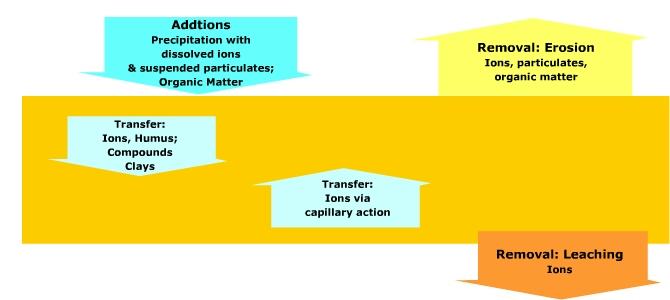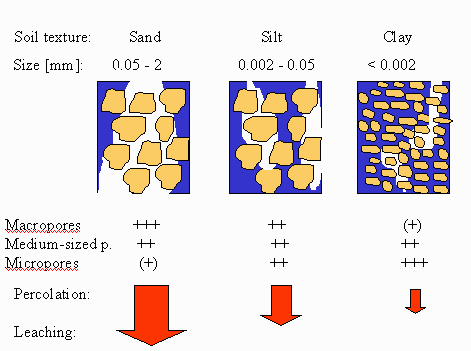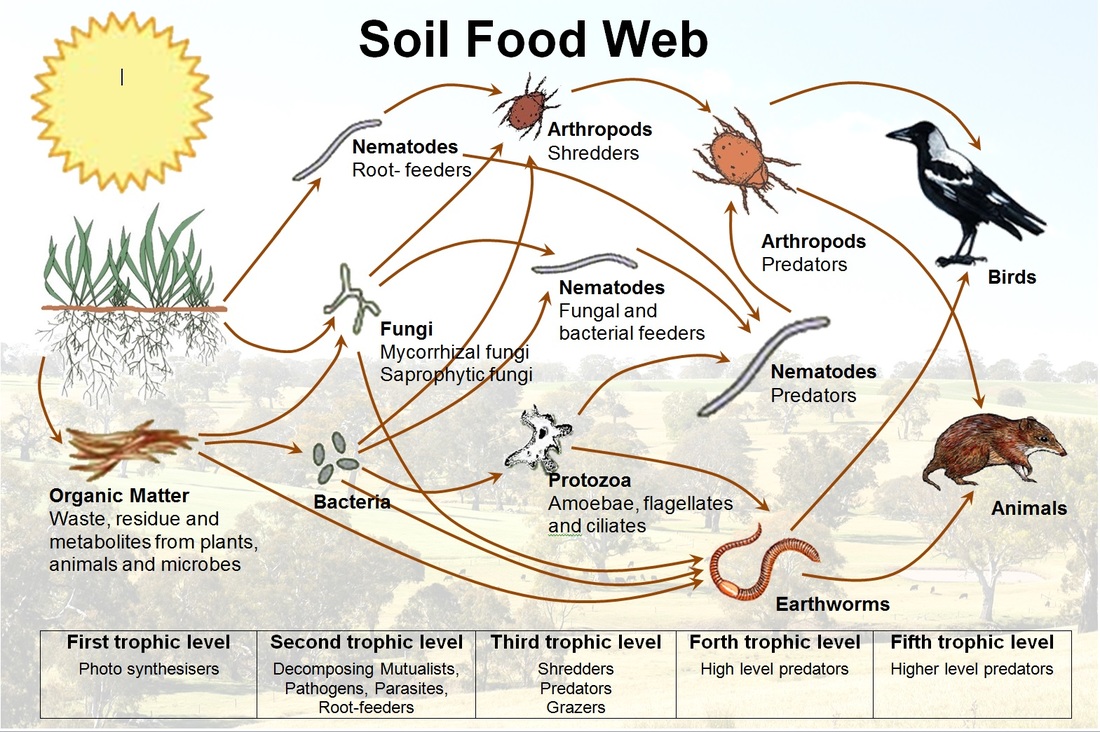topic 5.1: Introduction to Soil Systems
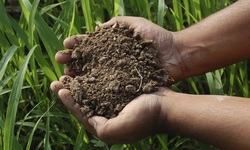 Image from Food Tank
Image from Food Tank
We tend to take the soil around us for granted. It is much more than mud, clay or dirt. All the food that we consume depends ultimately upon soil. Plants grow and depend on the soil. We either eat plants that grow directly in the soil or the animals that eat the plants.
Soils are the part of the lithosphere where life processes and soil forming processes both take place.
In this unit we will look at the soil system, soil water, soil formation and the consequences of soil degradation.
This unit is a minimum of 3 hours
Soils are the part of the lithosphere where life processes and soil forming processes both take place.
In this unit we will look at the soil system, soil water, soil formation and the consequences of soil degradation.
This unit is a minimum of 3 hours
Significant Ideas
- The soil system is a dynamic ecosystem that has inputs, outputs, storages and flows.
- The quality of soil influences the primary productivity of an area..
Big questions:
- What strengths and weaknesses of the systems approach and the use of models have been revealed through this topic?
- To what extent have the solutions emerging from this topic been directed at preventing environmental impacts, limiting the extend of the environmental impacts, or restoring systems in which environmental impacts have already occurred:
- What value systems can you identify at play in the cases and approaches to resolving the issues addressed in this topic?
- In what ways might the solutions explored in this topic alter your predictions for the state of human societies and the biosphere some decades from now?
- How does the systems approach help our understanding of soils and soil processes?
- With respect to soils, how might the environmental value systems of a large scale commercial farmer differ from that of a traditional subsistence farmer?
- How might the pressure on soils change over the next 20 years? Give reasons to support your answer.
Knowledge & Understanding:
5.1.U1 The soil system may be illustrated by a soil profile that has a layered structure (horizons).
[Studies of specific soil profiles, such as podsol, are not required.]
[Studies of specific soil profiles, such as podsol, are not required.]
- Identify the horizons of a soil profile - O, A, B and C
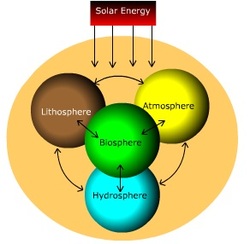
Soils are major components of the world's ecosystems.Soil forms the Earth’s atmosphere, lithosphere (rocks), biosphere (living matter) and hydrosphere (water). Soil is what forms the outermost layer of the Earth’s surface, and comprise weathered bedrock (regolith), organic matter (both dead and alive), air and water.
The soil interacts with the atmosphere, lithosphere, biosphere and hydrosphere.
Soil is a mixture of four basic parts – minerals, organic matter, air and water. It serves four primary functions:
Soils are important to humans in many ways:
The characteristics of soils will dependent on:
The soil interacts with the atmosphere, lithosphere, biosphere and hydrosphere.
- The water cycle moves through the soil by infiltration and water may evaporate from the surface.
- The atmosphere may contain particulate matter that is deposited on the soils and particles may blow up into the atmosphere.
- Rocks in the lithosphere weather to form soils, and soils at depth and pressure may form rocks.
- Plants in the biosphere may extract nutrients from the soils and dead plants may end up forming parts of the soil.
Soil is a mixture of four basic parts – minerals, organic matter, air and water. It serves four primary functions:
- Medium for plant growth. Soil supplies nutrients and water as well as anchors roots.
- Water storage and purification system.
- Habitat for organisms, such as bacteria, insects and mammals. These organisms modify the soil.
- Soil modifies the atmosphere through respiration of the soil organisms and plant roots.
Soils are important to humans in many ways:
- soil is the medium for plant growth, which most of foods for humans are grown in
- soil stores freshwater, 0.005% of world’s freshwater
- soil filters materials added to the soil, keeping quality water
- recycling of nutrients takes place in the soil when dead organic matter is broken down
- soil is the habitat for billions of micro-organisms, as well as other larger animals
- soil provides raw material in the forms of peat, clay, sands, gravel and minerals
The characteristics of soils will dependent on:
- Climate: Precipitation/evaporation determines the dominant direction of water movement.
- Organisms: Breaks down organic matter and mix it into the upper layers of the soil.
- Relief: The elevation, aspect of the slope (the direction it faces) and the angle of the slope.
- Parent material: The original material that the soil develops from. This can be either the bedrock or lake or glacial till that has been laid down on top of the bedrock.
- Time: Soil formation is a long and slow process, therefore it is considered to be a non-renewable natural capital. The amount of time the soil has had to form will affect its characteristics.
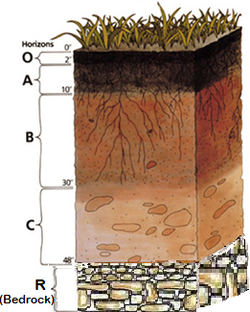 image from en.wikipedia.org
image from en.wikipedia.org
Soil Horizons.
- O) Organic matter: Litter layer of plant residues in relatively undecomposed form.
- A) Surface Soil: Layer of mineral soil with most organic matter accumulation and soil life. This layer eluviates (is depleted of) iron, clay and calcium, organic compounds, and other soluble constituents. When eluviation is pronounced, a lighter colored "E" subsurface soil horizon is apparent at the base of the "A" horizon. A-horizons may also be the result of a combination of soil bioturbation and surface processes that separates fine particles from biologically mounded topsoil. In this case, the A-horizon is regarded as a "biomantle".
- B) Subsoil: This layer accumulates iron, clay, aluminum and organic compounds, a process referred to as illuviation.
- C) Parent Rock: Layer of large unbroken rocks. This layer may accumulate the more soluble compounds.
- R) Bedrock: The parent material in bedrock landscapes. This layer denotes the layer of partially weathered bedrock at the base of the soil profile. Unlike the above layers, R horizons largely comprise continuous masses of hard rock that cannot be excavated by hand. Soils formed in situ will exhibit strong similarities to this bedrock layer. These areas of bedrock are under 50 feet of the other profiles.
5.1.U2 Soil system storages include organic matter, organisms, nutrients, minerals, air and water.
- Explain how soil can be viewed as a system
- Outline the soil system storages
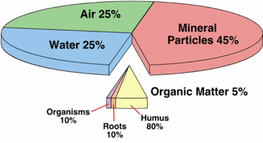 image from www.eoearth.org
image from www.eoearth.org
Soil has matter in all three states:
- organic and inorganic matter form the solid state
- soil water(from precipitation, groundwater and seepage) form the liquid state
- soil atmosphere forms the gaseous state
5.1.3U Transfers of material within the soil, including biological mixing and leaching (minerals dissolved in water moving through soil), contribute to the organization of the soil
- Outline the transfer of material in a soil profile
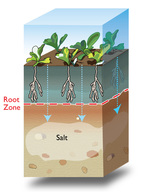 image from www.senninger.com
image from www.senninger.com
Translocation involves the movement of soil-forming materials through the developing soil profile. Translocation occurs by water running through the soil transferring materials from upper to lower portions of the profile. Burrowing animals like earth worms, ants, etc., move soil materials within the profile. Burrowing animals create passage ways through which air and water can travel promoting soil development.
5.1.U4 There are inputs of organic material including leaf litter and inorganic matter from parent material, precipitation and energy. Outputs include uptake by plants and soil erosion.
- Outline the inputs and outputs of the soil system.
 image from www.gov.mb.ca
image from www.gov.mb.ca
Inputs
1. Weathering
Rock weathering is one of the most important long-term sources for nutrients. However, this process adds nutrients to ecosystems in relatively small quantities over long periods of time. Important nutrients released by weathering include:
Calcium, magnesium, potassium, sodium, silicon, iron, aluminum, and phosphorus.
2. Atmospheric Input
Large quantities of nutrients are added to ecosystems from the atmosphere. This addition is done either through precipitation or by a number of biological processes.
Carbon - absorbed by way of photosynthesis.
Nitrogen - produced by lightning and precipitation.
Sulfur, chloride, calcium, and sodium - deposited by way of precipitation.
3. Biological Nitrogen Fixation
Biological nitrogen fixation is a biochemical process where nitrogen gas from the atmosphere is chemically combined into more complex solid forms by metabolic reactions in an organism. This ability to fix nitrogen is restricted to a symbiotic associations with legumes and other microorganisms.
Outputs
1. Erosion
Soil erosion is probably the most import means of nutrient loss to ecosystems. Erosion is very active in agricultural and forestry systems, where cultivation, grazing, and clearcutting leaves the soil bare and unprotected. When unprotected, the surface of the soil is easily transported by wind and moving water. The top most layers of a soil, which have an abundance of nutrient rich organic matter, are the major storehouse for soil nutrients like phosphorus, potassium, and nitrogen.
2. Leaching
Leaching occurs when water flowing vertically through the soil transports nutrients in solution downward in the soil profile. Many of these nutrients can be completely lost from the soil profile if carried into groundwater and then horizontally transported into rivers, lakes, or oceans. Leaching losses are, generally, highest in disturbed ecosystems. In undisturbed ecosystems, efficient nutrient cycling limits the amount of nutrients available for this process.
3. Gaseous Losses
High losses of nutrients can also occur when specific environmental conditions promote the export of nutrients in a gaseous form. When the soil is wet and anaerobic, many compounds are chemically reduced to a gas from solid forms in the soil. This is especially true of soil nitrogen.
5.1.U5 Transformations include decomposition, weathering and nutrient cycling.
- Explain how transfers and transformations contribute to the organization of the soil into horizons.
The transformation and movement of materials within soil organic matter pools is a dynamic process influenced by climate, soil type, vegetation and soil organisms. All these factors operate within a hierarchical spatial scale. Soil organisms are responsible for the decay and cycling of both macronutrients and micronutrients, and their activity affects the structure, tilth and productivity of the soil.
5.1.U6 The structure and properties of sand, clay and loam soils differ in many ways, including mineral and nutrient content, drainage, water-holding capacity, air spaces, biota and potential to hold organic matter. Each of these variables is linked to the ability of the soil to promote primary productivity
- Explain the impact soil texture has on mineral and nutrient content, drainage, water-holding capacity, air spaces, biota and potential to hold organic matter.
- Explain how soil texture impacts primary productivity.
Soil structure affects aeration, water-holding capacity, drainage, and penetration by roots and seedlings, among other things. Soil structure refers to the arrangement of soil particles into aggregates (or peds) and the distribution of pores in between. It is not a stable property and is greatly influenced by soil management practices.
Primary productivity of soils depend on
Primary productivity of soils depend on
- mineral content
- drainage
- water-holding capacity
- air spaces
- biota
- potential to hold organic matter
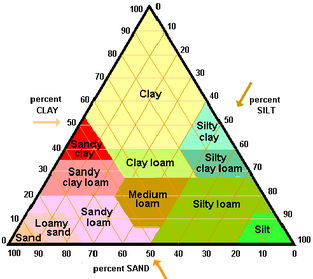
Consider mineral content, drainage, water-holding capacity, air spaces, biota and potential to hold organic matter, and link these to primary productivity.
Soil structure depends on:
For optimum structure, variety of pure sizes are required to allow root prevention, free drainage and water storage. Pore spaces over 0.1 mm allow roots growth, oxygen diffusion and water movement where as pore spaces below 0.5 mm help store water.
Soil structure depends on:
- Soil texture ( the amount of sand and clay )
- dead organic matter
- earthworm activity
For optimum structure, variety of pure sizes are required to allow root prevention, free drainage and water storage. Pore spaces over 0.1 mm allow roots growth, oxygen diffusion and water movement where as pore spaces below 0.5 mm help store water.
Application & Skills
5.1.A1 Outline the transfers, transformations, inputs, outputs, flows and storages within soil systems.
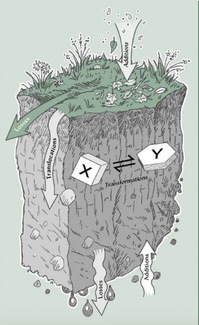
There are four basic processes that occur in the formation of soils,
inputs - physical movement of material within soil.
The two driving forces for these processes are climate (temperature and precipitation) and organisms, (plants and animals). Parent material is usually a rather passive factor in affecting soil processes because parent materials are inherited from the geologic world. Topography (or relief) is also rather passive in affecting soil processes, mainly by modifying the climatic influences of temperature and precipitation.
inputs - physical movement of material within soil.
- Minerals: The minerals of a soil come from the weathering of the parent material.
- Organic matter: Organic matter comes from the living organisms that are on and in the soil.
- Air: Certain plants also add some inputs to the soil.
- Water: The way in which water enters the soil is dependent one whether the soil is on a slope and where it is on that slope.
- leaching - downward loss of nutrients through soil layers
- uptake by plants
- radiation - albedo effect
- erosion
- deposition
- decomposition
- weathering
- nutrient cycling
- organic matter
- nutrients
- organisms
- minerals,
- air
- water
The two driving forces for these processes are climate (temperature and precipitation) and organisms, (plants and animals). Parent material is usually a rather passive factor in affecting soil processes because parent materials are inherited from the geologic world. Topography (or relief) is also rather passive in affecting soil processes, mainly by modifying the climatic influences of temperature and precipitation.
5.1.A2 Explain how soil can be viewed as an ecosystem.
Soil is the link between the air, water, rocks, and organisms, and is responsible for many different functions in the natural world that we call ecosystem services. These soil functions include: air quality and composition, temperature regulation, carbon and nutrient cycling, water cycling and quality, natural "waste" (decomposition) treatment and recycling, and habitat for most living things and their food. We could not survive without these soil functions.
Billions of organisms inhabit the upper layers of the soil, where they break down dead organic matter, releasing the nutrients necessary for plant growth. The micro-organisms include bacteria, actinomycetes, algae and fungi. Macro-organisms include earthworms and arthropods such as insects, mites and millipedes. Each group plays a role in the soil ecosystem and can assist the organic farmer in producing a healthy crop. Micro-organisms can be grouped according to their function: free-living decomposers convert organic matter into nutrients for plants and other micro-organisms, rhizosphere organisms are symbiotically associated with the plant roots and free-living nitrogen fixers.
Billions of organisms inhabit the upper layers of the soil, where they break down dead organic matter, releasing the nutrients necessary for plant growth. The micro-organisms include bacteria, actinomycetes, algae and fungi. Macro-organisms include earthworms and arthropods such as insects, mites and millipedes. Each group plays a role in the soil ecosystem and can assist the organic farmer in producing a healthy crop. Micro-organisms can be grouped according to their function: free-living decomposers convert organic matter into nutrients for plants and other micro-organisms, rhizosphere organisms are symbiotically associated with the plant roots and free-living nitrogen fixers.
5.1.A3 Compare and contrast the structure and properties of sand, clay and loam soils, with reference to a soil texture diagram, including their effect on primary productivity.
[Familiarity with the soil texture triangle diagram used for soil type classification based on the percentage of sand, silt, and clay in the soil is required.]
[Familiarity with the soil texture triangle diagram used for soil type classification based on the percentage of sand, silt, and clay in the soil is required.]
- Apply the soil triangle to compare and contrast the composition of soils.
- Compare and contrast different soil textures with reference to the soil triangle.
- Compare and contrast the properties of sand, clay and loam soils.
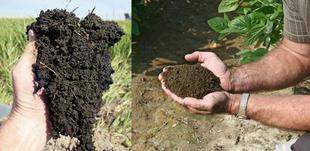
Soil structure depends on:
Clay:
Different soil types have different levels of primary productivity:
Primary productivity of soil depends on:
*Shrinking limit: state which the soil passes from having a moist to a dry appearance.
*Plastic limit: occurs when each ped is surrounded by a film of water sufficient to act as a lunricant.
*Liquid limit: occurs when there is sufficient water to reduce cohesion between the peds.
*Field capacity: maximum amount of water that a particular soil can hold.
- Soil texture ( the amount of sand and clay )
- dead organic matter
- earthworm activity
Clay:
- fertile in temperate locations
- in tropical areas clay is permeable and easily penetrated by roots
- nutrient deficient / easily leached in tropics
Different soil types have different levels of primary productivity:
- sandy soil – low
- clay soil – quite low
- loam soil – high
Primary productivity of soil depends on:
- mineral content
- drainage
- water-holding capacity
- airspaces
- biota
- potential to hold organic materials
*Shrinking limit: state which the soil passes from having a moist to a dry appearance.
*Plastic limit: occurs when each ped is surrounded by a film of water sufficient to act as a lunricant.
*Liquid limit: occurs when there is sufficient water to reduce cohesion between the peds.
*Field capacity: maximum amount of water that a particular soil can hold.
Key Terms
|
soil
parent material transformation water holding capacity soil texture minerals |
lithosphere
precipitation decomposition biota sand porosity |
soil profile
infiltration weathering clay permeability bedrock |
deposition
leaching nutrient cycle mineral content silt soil horizon |
organic material
drainage loam humus glacial moraines sheet wash |
Classroom Materials
Soils article
Simulation Lab: Soils
Soil Types Comparison International Assessment
Soils article
Simulation Lab: Soils
Soil Types Comparison International Assessment
Powerpoint and Notes Adapted from Brad Kremer and Masfar
Your browser does not support viewing this document. Click here to download the document.
Your browser does not support viewing this document. Click here to download the document.
Correct use of terminology is a key skill in ESS. It is essential to use key terms correctly when communicating your understanding, particularly in assessments. Use the quizlet flashcards or other tools such as learn, scatter, space race, speller and test to help you master the vocabulary.
Useful Links
Soils of the World
Smithsonian: The Secrets of Soil
From the Ground Up: The Science of Soil
Soil Basics
Soil Types
The Dirt on Soil - Student Science
Soil Horizons animation - Wiley
Basic Properties of the Soil - eHow
This animation shows chemical weathering - North Carolina State University
This animation describes soil horizons’ - Wiley
Click here for an interactive soil triangle - North Carolina State University,
Down on Dirt - Discovery Education
Secret of Soil - National Museum of Natural History
Animated Soil Pyramid - North Carolina State University
Soil Formation Animation - North Carolina State University
International Year of Soil
In The News
Here's How Earth's Soil Can Save The Planet From Global Warming - April 2016
Our Good Earth - National Geographic
International-mindedness:
- Significant differences exist in arable (potential to promote primary productivity) soil availability around the world. These differences have socio-political, economic and ecological influences.
Theory of knowledge:
- The soil system may be represented by a soil profile—since a model is, strictly speaking, not real, how can it lead to knowledge?
Videos
Healthy soil is fundamental for functioning ecosystems and critical for our own food and nutritional security. We need to dramatically rethink the important role of soil health and agriculture within the upcoming United Nations Decade on Ecosystem Restoration as well as the climate change agenda
A new, seven-part video series explores how an increasing number of farmers throughout the country are creating a new hope in healthy soil by regenerating our nation’s living and life-giving soil.
Julia Roberts, Harrison Ford, Edward Norton, Penélope Cruz, Robert Redford and Ian Somerhalder all join forces to give nature a voice.
Excursion into the realms of soil, the number 1 lifegiver on Earth...It's fundamentally important ecological functions, our poor understanding of it as well as our destructive relationship with it. They are so essential to life and thus to us, that our survival is directly dependent on their understanding and protection!
In "Soil Stories", our protagonist, Francine, embarks on a journey of discovery that begins with her realization that soil is alive and that without soil, life as we know would not exist.
In this video Paul Andersen explains how soils are formed and classified. Weathering of rock creates particles which are mixed with water, air, and organic material. Soils are classified according to particle size, chemical makeup, and horizon distribution. A brief discussion of soil loss through erosion, compaction, and salinization is included.
Learn all about soil texture and how to test for clay, silt and sand
With the help of sound management practices, water can move into the soil rather than running off. This video describes how and why soils transmit water at different rates
Fred Kirschenmann has been involved in sustainable agriculture and food issues for most of his life. He currently serves as both a Distinguished Fellow at the Leopold Center for Sustainable Agriculture at Iowa State University, and as President of the Stone Barns Center for Food and Agriculture in Pocantico Hills, New York.
